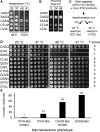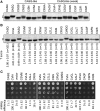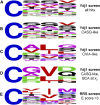Protein Isoprenylation in Yeast Targets COOH-Terminal Sequences Not Adhering to the CaaX Consensus
- PMID: 30257935
- PMCID: PMC6283164
- DOI: 10.1534/genetics.118.301454
Protein Isoprenylation in Yeast Targets COOH-Terminal Sequences Not Adhering to the CaaX Consensus
Abstract
Protein isoprenylation targets a subset of COOH-terminal Cxxx tetrapeptide sequences that has been operationally defined as a CaaX motif. The specificity of the farnesyl transferase toward each of the possible 8000 combinations of Cxxx sequences, however, remains largely unresolved. In part, it has been difficult to consolidate results stemming from in vitro and in silico approaches that yield a wider array of prenylatable sequences relative to those known in vivo We have investigated whether this disconnect results from the multistep complexity of post-translational modification that occurs in vivo to CaaX proteins. For example, the Ras GTPases undergo isoprenylation followed by additional proteolysis and carboxymethylation events at the COOH-terminus. By contrast, Saccharomyces cerevisiae Hsp40 Ydj1p is isoprenylated but not subject to additional modification. In fact, additional modifications are detrimental to Ydj1p activity in vivo We have taken advantage of the properties of Ydj1p and a Ydj1p-dependent growth assay to identify sequences that permit Ydj1p isoprenylation in vivo while simultaneously selecting against nonprenylatable and more extensively modified sequences. The recovered sequences are largely nonoverlapping with those previously identified using an in vivo Ras-based yeast reporter. Moreover, most of the sequences are not readily predicted as isoprenylation targets by existing prediction algorithms. Our results reveal that the yeast CaaX-type prenyltransferases can utilize a range of sequence combinations that extend beyond the traditional constraints for CaaX proteins, which implies that more proteins may be isoprenylated than previously considered.
Keywords: CaaX; Hsp40; farnesyl transferase; isoprenylation; thermotolerance.
Copyright © 2018 by the Genetics Society of America.
Figures






Similar articles
-
A shunt pathway limits the CaaX processing of Hsp40 Ydj1p and regulates Ydj1p-dependent phenotypes.Elife. 2016 Aug 15;5:e15899. doi: 10.7554/eLife.15899. Elife. 2016. PMID: 27525482 Free PMC article.
-
A comprehensive in vivo screen of yeast farnesyltransferase activity reveals broad reactivity across a majority of CXXX sequences.G3 (Bethesda). 2023 Jul 5;13(7):jkad094. doi: 10.1093/g3journal/jkad094. G3 (Bethesda). 2023. PMID: 37119806 Free PMC article.
-
Sequence dependence of protein isoprenylation.J Biol Chem. 1991 Aug 5;266(22):14603-10. J Biol Chem. 1991. PMID: 1860864
-
Thematic review series: lipid posttranslational modifications. CAAX modification and membrane targeting of Ras.J Lipid Res. 2006 May;47(5):883-91. doi: 10.1194/jlr.R600004-JLR200. Epub 2006 Mar 16. J Lipid Res. 2006. PMID: 16543601 Review.
-
Enzymology and biology of CaaX protein prenylation.Recent Prog Horm Res. 1999;54:315-42; discussion 342-3. Recent Prog Horm Res. 1999. PMID: 10548882 Review.
Cited by
-
PKC98E Regulates Odorant Responses in Drosophila melanogaster.J Neurosci. 2021 May 5;41(18):3948-3957. doi: 10.1523/JNEUROSCI.3019-20.2021. Epub 2021 Mar 31. J Neurosci. 2021. PMID: 33789918 Free PMC article.
-
Updates on protein-prenylation and associated inherited retinopathies.Front Ophthalmol (Lausanne). 2024 Jul 4;4:1410874. doi: 10.3389/fopht.2024.1410874. eCollection 2024. Front Ophthalmol (Lausanne). 2024. PMID: 39026984 Free PMC article. Review.
-
Extending the reach of homology by using successive computational filters to find yeast pheromone genes.Curr Biol. 2023 Oct 9;33(19):4098-4110.e3. doi: 10.1016/j.cub.2023.08.039. Epub 2023 Sep 11. Curr Biol. 2023. PMID: 37699395 Free PMC article.
-
Evaluating protein prenylation of human and viral CaaX sequences using a humanized yeast system.Dis Model Mech. 2024 May 1;17(5):dmm050516. doi: 10.1242/dmm.050516. Epub 2024 May 31. Dis Model Mech. 2024. PMID: 38818856 Free PMC article.
-
Molecular identification and expression patterns of sweet cherry HIPPs and functional analysis of PavHIPP16 in cold stress.Planta. 2024 Nov 6;260(6):134. doi: 10.1007/s00425-024-04567-z. Planta. 2024. PMID: 39505755
References
Publication types
MeSH terms
Substances
Associated data
Grants and funding
LinkOut - more resources
Full Text Sources
Other Literature Sources
Molecular Biology Databases

